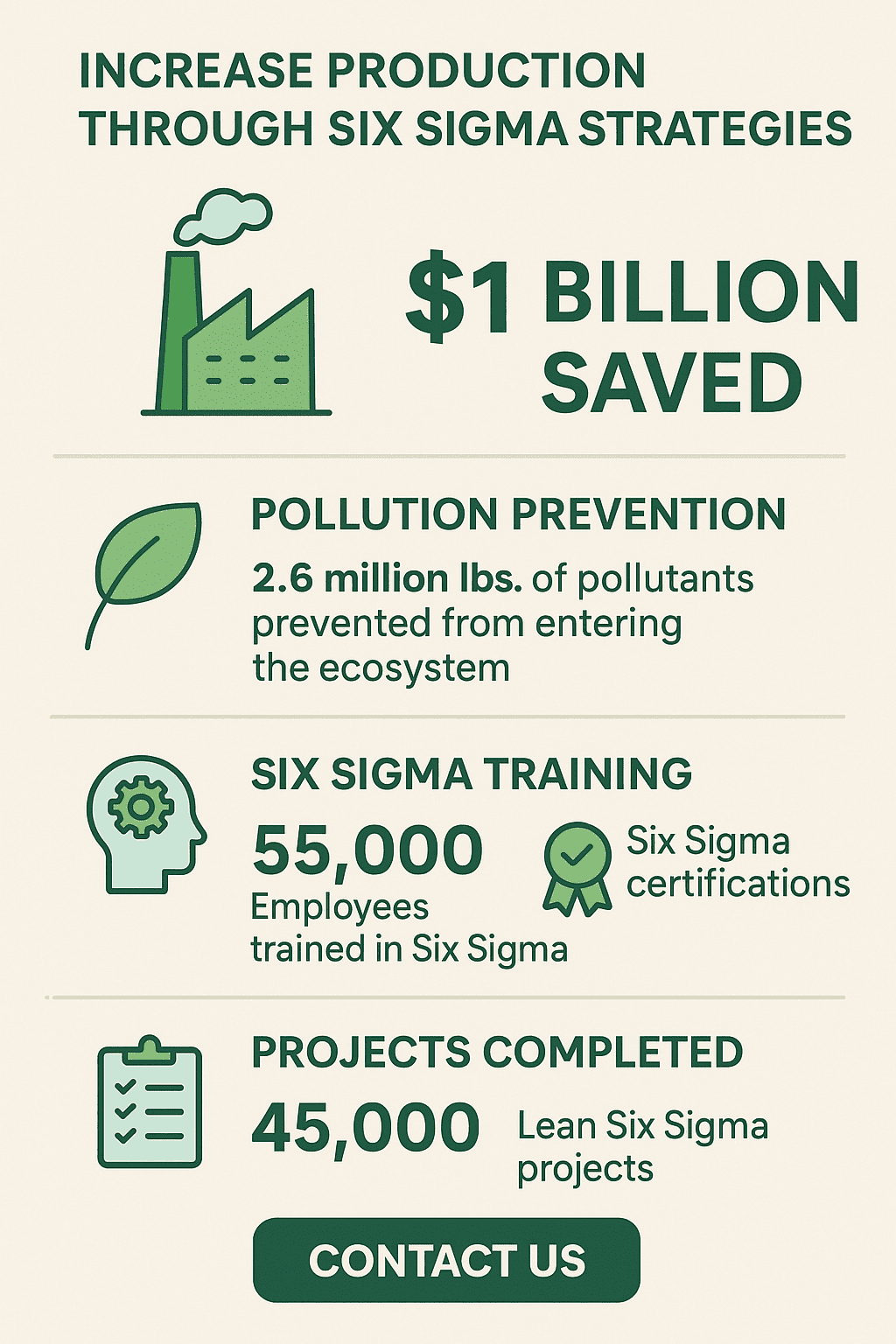How a Multinational Conglomerate Saved $1 Billion Using Six Sigma: A Powerful Case Study in Productivity, Sustainability, and Operational Excellence
Did you know that one of the world’s most respected multinational conglomerate corporations achieved over $1 billion in savings simply by implementing Six Sigma strategies? This remarkable transformation not only improved their profitability but also positioned them as a global leader in environmental responsibility. Their success story demonstrates how structured problem-solving, disciplined execution, and organization-wide capability building can create a ripple effect across financial, operational, and environmental dimensions.
This organisation recognized early that waste, pollution, and inefficiencies were not just environmental concerns they were business concerns. Their leadership believed that pollution prevention is far more impactful when done proactively rather than reactively. Instead of waiting for environmental issues to escalate, they chose to address inefficiencies at the source, ensuring long-term sustainability and operational reliability.
The results?
A massive $1 billion saved, and nearly 2.6 million pounds of pollutants prevented from entering the ecosystem. These achievements didn’t happen overnight—they were the result of a long-term, strategic application of Six Sigma principles.
Building Capability: 55,000+ Employees Trained in Six Sigma
One of the most significant components of this transformation was the organisation’s commitment to capability building. Realizing that Six Sigma is only effective when embraced by the entire workforce, the company launched one of the largest corporate training initiatives ever undertaken in the field of quality and operational improvement.
-
55,000 employees were trained in Six Sigma principles
-
Participants earned Six Sigma Green Belt, Black Belt, or Yellow Belt certifications
-
These skilled employees facilitated nearly 45,000 Six Sigma projects across departments
This widespread skill development created a culture of continuous improvement. Employees at every level were empowered to identify inefficiencies, solve problems using data, and drive measurable outcomes.
By 2007, the company went even further. They trained an additional set of Six Sigma leaders, including new Black Belts and even Master Black Belts, who were responsible for deploying the strategy across the entire organization. Every team across production, R&D, supply chain, and support functions—was required to have at least one certified Six Sigma Green Belt. This ensured that improvement thinking was embedded deeply into daily operations.
To achieve Green Belt certification, team members had to undergo two weeks of intensive Six Sigma training, equipping them with tools for data-driven decision-making, process mapping, and root-cause analysis. This level of discipline allowed the organization to consistently deliver high-quality outcomes.
Driving Production and Sustainability Through Six Sigma
One of the core objectives of the organization was to increase production and efficiency while reducing waste and pollution. Their Six Sigma initiatives were not isolated projects—they were an integrated strategy to enhance productivity, sustainability, and cost competitiveness simultaneously.
The organisation focused on:
-
Reducing waste across the production chain
-
Minimizing air emissions
-
Lowering greenhouse gas production
-
Improving energy efficiency
-
Enhancing overall operational performance
By 2006, over 70% of their operations were being run using Six Sigma methodologies. This widespread adoption ensured that improvement wasn’t limited to one department but extended across the entire enterprise.
Record-Breaking Environmental Gains
The results achieved through Six Sigma were nothing short of extraordinary.
1. Unpredictable Air Emissions Reduced by 61%
The target was a modest 25% reduction. But through disciplined Six Sigma methods—such as root-cause analysis, DMAIC, statistical process control, and real-time monitoring—they achieved a 61% reduction, far surpassing expectations.
2. Toxic Release Inventory (TRI) Reduced by 64%
While the organisational goal was a 50% reduction, the company exceeded it significantly, demonstrating that data-based decision making can lead to exceptional environmental gains.
3. Energy Efficiency Improved by 27%
The initial target was a 20% improvement in energy efficiency. Their Six Sigma-driven interventions delivered 27%, reflecting enhanced machine performance, reduced downtime, and better production planning.
4. Pollution Prevention Pays (PPP) Program Expanded Beyond Expectations
One of the company’s long-standing environmental initiatives aimed to scale the number of Pollution Prevention Pays projects from 194 to 400. Instead, Six Sigma helped them reach an astonishing 1,262 projects—more than three times the goal.
Every project contributed not just to pollution prevention but also to cost savings, making environmental stewardship financially rewarding.
The Power of Six Sigma: Why It Works
Six Sigma isn’t simply a quality-control tool it is a comprehensive methodology that systematically removes defects, reduces variation, and improves processes. Its strength lies in:
-
Data-driven decision making
-
Statistical analysis
-
Waste elimination (lean integration)
-
Structured frameworks like DMAIC and DMADV
-
Organization-wide involvement
-
Clear targets and measurable metrics
This multinational conglomerate proved that when applied consistently and intelligently, Six Sigma can transform not only the bottom line but also environmental performance and operational resilience.
What This Means for Organisations Today
The success of this corporation is not an isolated case. Six Sigma has helped companies across industries manufacturing, chemicals, healthcare, FMCG, automotive, and electronics increase productivity, improve quality, and reduce operational costs.
These strategies are not just for large corporations. Even mid-sized companies can:
-
Reduce defects
-
Lower rework costs
-
Improve delivery performance
-
Increase production capacity
-
Reduce waste and energy usage
-
Strengthen employee skills
With the right training, structure, and guidance, organisations can replicate similar results regardless of their size or sector.
Have You Started Implementing Six Sigma Strategies Yet?
This case shows clearly that Six Sigma is more than a methodology it is a competitive advantage. Whether your goal is cost reduction, waste elimination, sustainability, or operational excellence, Six Sigma provides a proven roadmap.
If a global corporation can save $1 billion, prevent millions of pounds of pollutants, and complete thousands of improvement projects, imagine what your organization can achieve with the right Six Sigma strategy.
So, the real question is:
Have you started implementing Six Sigma in your organisation? If not, now is the time to begin.
Contact us for Six Sigma Consultant





